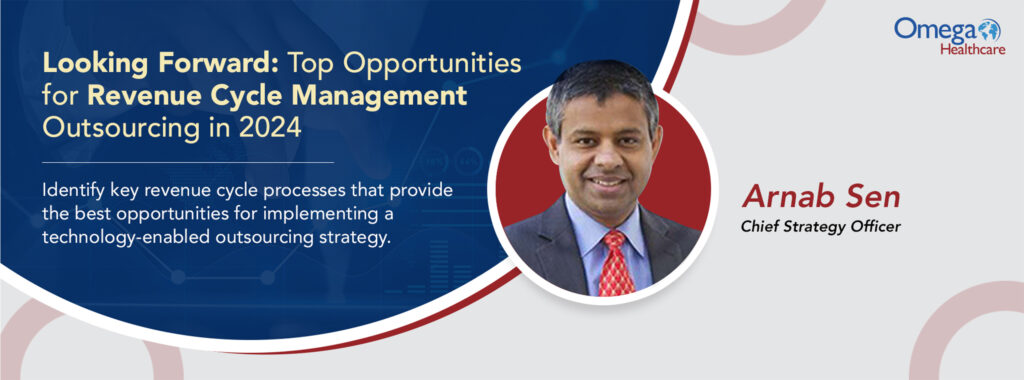Addressing the top challenges in revenue cycle management Arnab Sen, Chief Strategy Officer, Omega Healthcare Revenue cycle leaders continue struggling to regain a sense of normalcy and financial vitality since the COVID-19 crisis. Kaufman Hall’s November 2023 Hospital Flash Report indicates that operating margins are finally stabilizing to pre-pandemic levels while patient volumes are steady.[1] The report also states that labor-related costs have declined slightly, offsetting inflationary pressures. Even with these hopeful trends, revenue cycle leaders face ongoing challenges around long-standing and growing issues of denials, prior authorizations, payer audits and takebacks, cybersecurity threats, and the continued march toward value-based payment models. Now, more than ever, outsourcing adds significant value to sluggish revenue cycle performance. Below are key revenue cycle processes and workflows that provide the best opportunities for implementing an outsourcing strategy.
Reimbursement issues in healthcare have hit an all-time high.
Ways outsourcing can address today’s challenges in revenue cycle management
According to Deloitte’s new annual healthcare outlook survey, health leaders should “identify their core competencies and explore outsourcing for functions that can be performed more efficiently and cost-effectively.”[2] The following revenue cycle processes can bring significant outsourcing benefits for healthcare providers in relatively little time and with no new infrastructure investments. Denials Management. It’s a fact: Payers deny more claims than ever before, causing significant reimbursement issues in healthcare. Recent data analysis of hospitals and health systems found that Medicare Advantage and commercial denials have skyrocketed by 56% and 20%, respectively.[3] Another survey by MGMA found that nearly 70% of medical groups have experienced an increase in denials, with the average increase being 17%.[4] Payer denials are growing for many reasons, not the least of which is the more sophisticated technology they use to identify and flag potential claim issues, especially around medical necessity. Labor shortages, inexperienced staff, and poor coding quality are also challenges leading to denials and reimbursement issues in healthcare. Outsourcing companies can help providers reduce denied claims in multiple ways. The first is by shoring up patient access processes like eligibility verification and coverage discovery. The best partners leverage automation technology that streamlines these typically manual, error-prone processes, leading to greater accuracy and fewer denials. Conducting this discovery before the patient arrives can jump-start the revenue cycle and improve cash collection. Second, outsourcing companies can improve coding quality by leveraging a team of highly trained certified coders who use computer-assisted coding (CAC) with artificial intelligence (AI) technologies. Coding has become highly complex, requiring years of expertise from seasoned coders and improved clinical documentation. Poor quality or missing documentation, outdated code sets, and under- or over-coding are top issues that can lead to denials and compliance risks. When choosing an outsourcer, providers should look for one that uses CAC and requires its coders to maintain certification and ongoing training. According to AHIMA (American Health Information Management Association), computer-assisted coding technology (CAC) can increase coder productivity by 20 percent.[5] CAC can improve coding quality and reduce denied claims by matching codes to the medical diagnosis, procedure, or phrases in the patient chart.AI and automation used for medical coding results in fewer denied claims, rework, or partial reimbursements and produces coding results in hours or minutes, not days or weeks – significantly improving the speed of the revenue cycle.[6]Prior Authorizations. Surveys convey how troublesome prior authorizations (PAs) have become for providers, with 94% saying PAs cause delays in care, 80% saying they can lead patients to abandon their treatment, and 33% saying they’ve led to serious adverse events.[7] Prior authorizations are now one of the top challenges in revenue cycle management and one that federal agencies are beginning to address. One of the biggest concerns providers face in managing prior authorizations is that each payer has unique requirements, making it difficult for already overworked revenue cycle teams to stay on top of each process. Just understanding what does or does not require prior authorization can be challenging. According to the American Medical Association, 62% of physicians say it’s difficult to determine if a medical service requires prior authorization, while 14% say it’s “extremely difficult.”[8]
Eighty-eight percent of providers surveyed said prior authorizations were a “high” or “extremely high” burden, with 35% having staff solely dedicated to managing them, making the process a perfect candidate for outsourcing.[9]When choosing a partner, providers should look for one that leverages technology like robotic process automation (RPA) to streamline processes. RPA uses rules-based actions to mimic repetitive human tasks through user-defined scripts, or “bots, making it perfect for automating time-consuming processes like data entry. RPA is also ideal for prior authorizations as it can identify and flag documentation requirements for staff. This reduces administrative burdens and helps mitigate the challenge of determining when prior authorization is needed. Payer Audits and Takebacks. Payer audits and takebacks have soared.[10] The American Medical Association says, “insurance company takeback schemes are costing physicians and hospitals more than $1.6 billion a month.”[11] Providers have also experienced a “50 percent increase in risk-based audits across professional and hospital billing and a 170 percent increase in hierarchical conditions coding (HCC) audits.”[12] The challenge for providers is that coding and coding reviews can significantly burden already overwhelmed staff. Yet, not maintaining compliance can lead to not just takebacks but also significant penalties. Providers could also miss considerable shared savings by not maintaining HCC coding compliance. When choosing an outsourcing partner to help avoid and better prepare for payer audits, revenue cycle leaders should select one with the expertise necessary to perform regular retrospective chart reviews via diagnostic code abstraction, which can help verify optimal coding compliance and completeness.
Omega Healthcare can help providers address their reimbursement issues
Omega Healthcare offers a comprehensive suite of mid-revenue cycle services that help providers increase efficiencies, reduce costs, accelerate cash flow, and optimize revenue—all while enhancing the patient experience. Over 7,000 medical coding specialists on staff code more than 118 million charts annually. The team leverages the Omega Digital Platform which includes sophisticated workflow and CAC tools, artificial intelligence, RPA, and natural language processing to deliver faster turnaround times, more accurate coding, and fewer rejections and denials. Omega Healthcare commits to achieving greater than 95% audit accuracy, processing nearly 16% of all emergency medicine charts in the US. In addition to coding for hospitals and physicians, the team has expertise in radiology, emergency departments, pathology, EMS, anesthesia, urgent care, home health, hospice, IP DRG, and more.Omega Healthcare has a library with more than 1.5 million payer-specific rules to provide faster turnaround and fewer denials related to medical necessity.Omega Healthcare can help with HCC coding reviews, too. With 800 HCC coding specialists who code charts for 5 million patients and members each year, they have the expertise required to help providers prepare and submit accurate and complete data before CMS deadlines. Omega Healthcare can help customers achieve compliance goals and optimize reimbursement with less effort.




